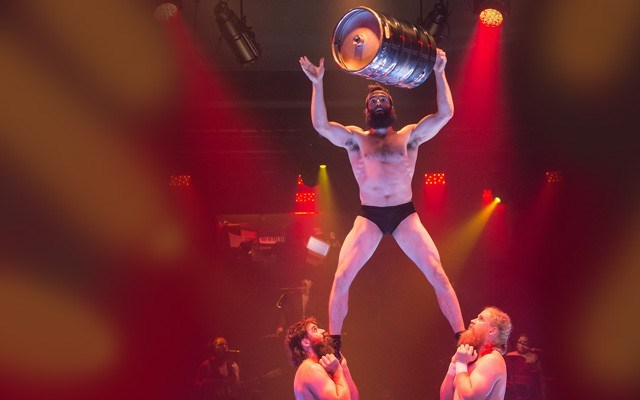It's a jolt to the system when a large group of people behind you suddenly clap their hands together in unison. And yet another after you turn to discover they're all buff, manic-eyed twentysomethings dressed identically in short shorts, red knee stockings and old school aviator helmets who insist you follow them down the street, tout de suite.
But this was a daily occurrence for pedestrians in Montreal's famous Latin Quarter this summer and, perhaps surprisingly, it wasn't part of yet another Just For Laughs hidden camera gag. Instead, it marked the beginning of yet another free public performance offered as part of Montréal Complètement Cirque, a city-wide two-week festival now in its sixth year and a growing Quebec cultural institution in its own right.
The performers were all "Minutiens," members of the Les Minutes Complètement Cirque troupe, who led the crowd to a nearby university courtyard on Rue Saint-Denis for a highly athletic show heavy on audience participation. Volunteers from the audience, young and old alike, were paired up with performers before playing a series of games that were a bit like a mashup of Frozen Tag and Simon Says, only with backflips, feats of strength and improv comedy. The crowd loved it, but it was actually only the warm-up for the far more elaborate outdoor "Duels" show held shortly afterward at nearby Place Emilie-Gamelin featuring tightrope walking, aerial silk routines, Chinese pole balancing and general flying through the air with the greatest of ease. All without a net.
Once upon a time, people had to run away to join the circus. In la belle province, thanks in no small part to an emerging cottage industry launched by the global success of homegrown Cirque du Soleil, it is becoming a viable career choice for young people entering the work force.
"There is now a very big talent pool," said Duels director Anthony Venisse, a trapeze and clown specialist from France who now teaches at the city's National Circus School, the only accredited school in North America offering high school and post-secondary students professional training in circus arts. "Everything started 30 years ago (when the school opened), and then the Cirque du Soleil came and then it just became a huge thing."
Former Montreal Canadiens goaltender Patrick Roy is often cited as the reason so many NHL goalies today are from Quebec because he made making saves seem more appealing than scoring goals for the likes of Marc-André Fleury, Jonathan Bernier, Roberto Luongo and many more. In a similar fashion, many Quebecois have grown up in an era after two French-Canadian buskers, Guy Laliberté and Gilles Ste-Croix, created a multi-billion dollar empire out of a small Canada Council grant given to mark the 450th anniversary of Jacques Cartier's voyage to the New World.
But while Cirque du Soleil's founders deserve much of the credit for the province's flourishing scene, Quebec has long been a stronghold for circus arts. It was home to the first touring circuses in Canada back in the 19th century, which became a part of French-Canadian tradition, and major cultural events such as Expo 67, the Superfrancofête of 1974 and the Montreal Summer Olympics all helped create a (literal) niche for street performers and various artist collectives. People realized there was bread to be made in circuses.
"There are so many artists studying here but also just staying to create new work," said Venisse. "In North America, it's by far the biggest area for it and, while there is still much more of a circus tradition in Europe, there are maybe only five other places in the world where the quality of teaching is as high as it is here."
The culture also seems to be just as varied as any artistic movement. For example, while the Minutes performance offered all the athleticism and derring-do people have come to expect from a Cirque show, it also had an emphasis on involving regular people. The show included 20 non-professionals in the cast, most memorably a woman confined to a wheelchair who performed a beautiful pas de deux with a male acrobat who used her chair as a balancing platform.
"When she raises her arms near the end, that is almost as difficult for her as anything [the professionals] are being asked to do," said Vinesse. "It is very moving to include people from outside our community and see them fall in love with it. This is the first year we've tried it and it has been a great success."
It was also hard to imagine the circus freaks of Cirque Alfonse feeling at home under Cirque du Soleil's big top. Their show "BARBU foire électro trad," which I was fortunate to catch as part of a recent media circus tour organized by Tourisme Montreal, was unlike anything I'd ever seen. And I've seen five different Cirque du Soleil shows.
Imagine a punk rock version of a Cirque show, only instead of the G-rated crowd-pleasers, you've got dudes with strongman builds and giant beards stripped down to their Speedos juggling kegs of beer while standing on top of each other's shoulders while a Gogol Bordello-like band rock out in the background. Or acrobatic female mud wrestling refereed by a whip-cracking dominatrix. Or a grey-haired stagehand in a pig suit dancing to Motorhead between acts. Puppetry and penises. Guinea pigs both figurative and literal. This is definitely not your grandparent's Ringling Brothers.
Instead, it's just the latest twist on an art form that goes back several centuries but shows no sign of packing up and moving on. Ladies and gentlemen, you won't believe your eyes.
The seventh annual Montréal Complètement Cirque festival is scheduled for July 2016.
LINKS:
Montréal Complètement Cirque:
http://montrealcompletementcirque.com
CIRQUE ALFONSE:
http://www.cirquealfonse.com/en
Tourisme Montreal:




